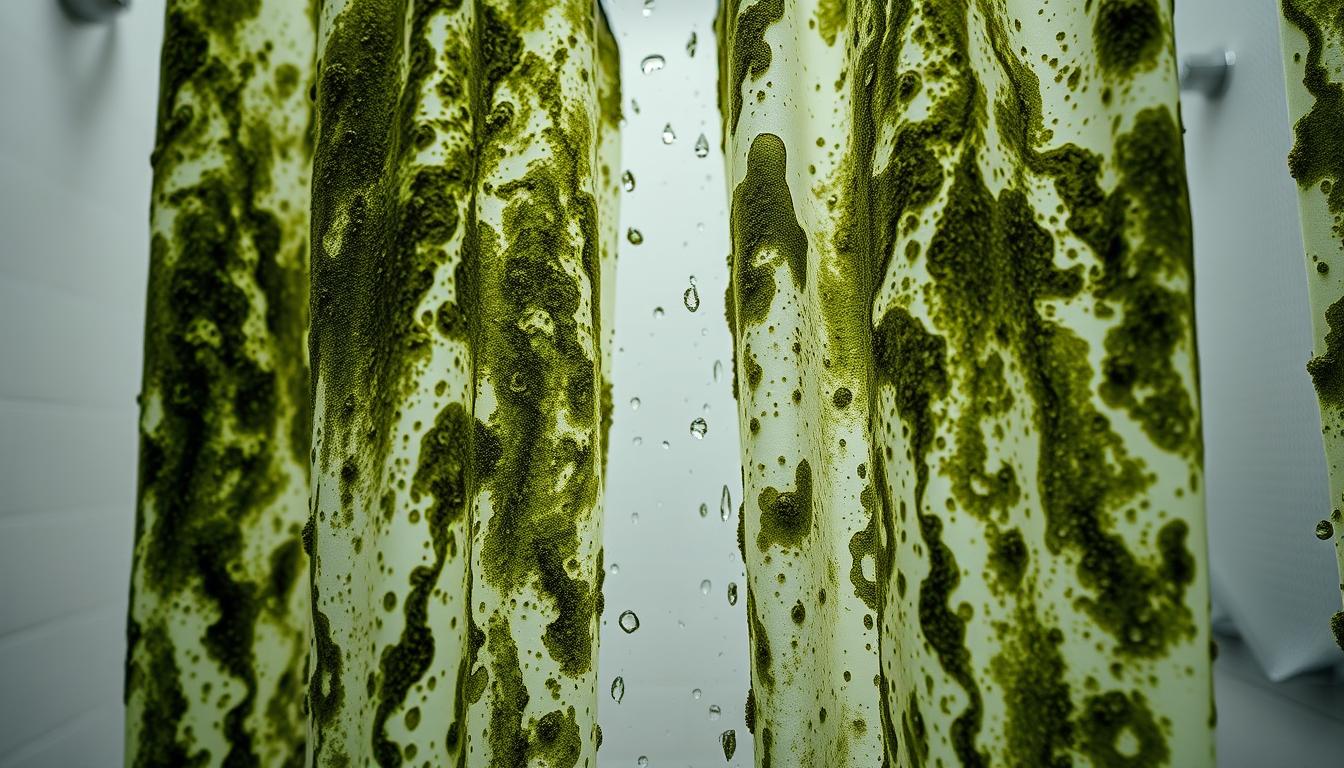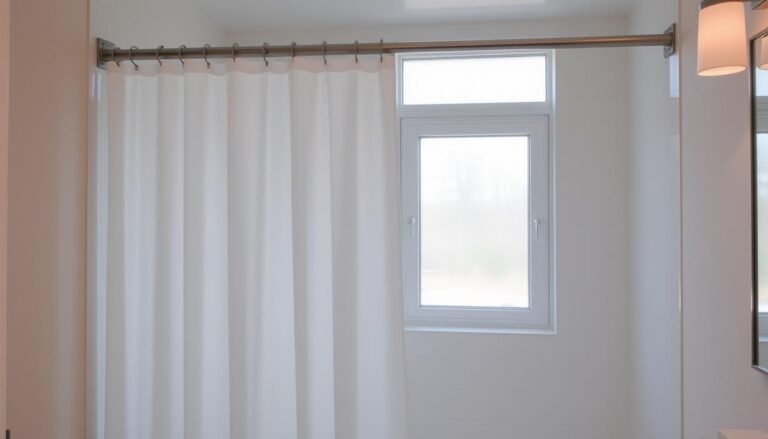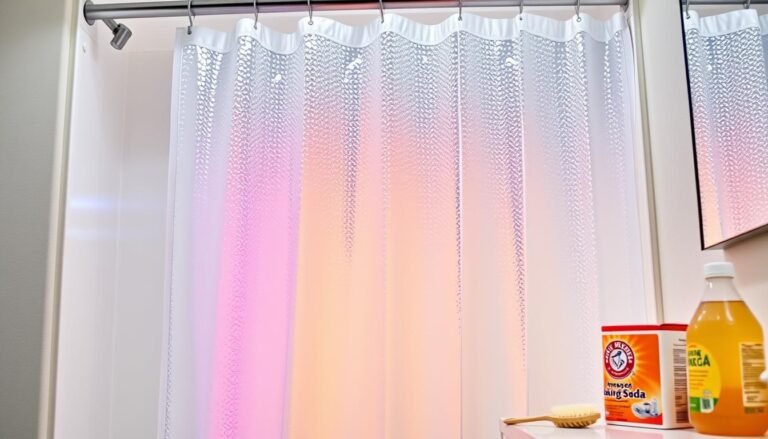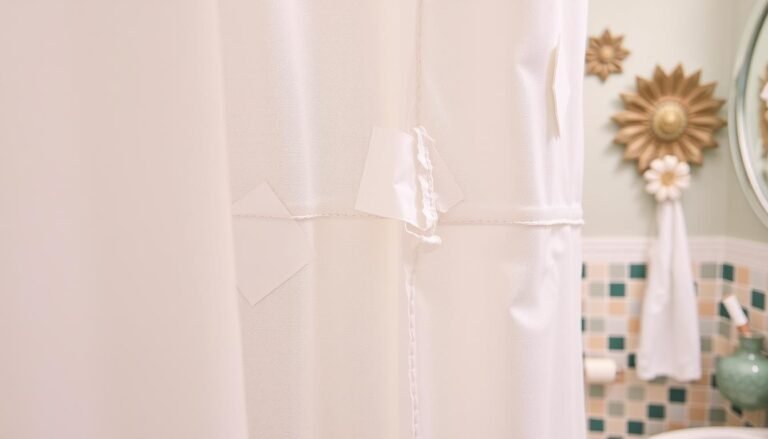Health Risks of Shower Curtain Mold Exposed
It’s easy to forget about, but the health risks of shower curtain mold are real. Moisture in the bathroom makes a perfect home for mold and mildew. Though most molds are not toxic, the CDC says they can make allergies and breathing problems worse. Dr. Jeffrey Brown, a family medicine expert, notes healthy people usually don’t have to worry. But those with weaker immune systems should be careful.
Keeping your shower curtain free from mold is key. Dr. Philip Tierno, a microbiologist, suggests airing out the bathroom and drying surfaces after showering. He also recommends changing the shower curtain or liner every six months to a year. Nelson Barnes Jr., a mold remediation expert, mentions that mold can cause sneezing and coughing. However, it’s not likely to cause serious health problems under normal circumstances.
To fight mold on shower curtains, clean the tub and shower walls every week. Use bleach-based cleaners for the best results. Keeping toiletries organized helps reduce spots for mold to grow. Good ventilation is key to keeping the area dry. These tips can make your bathroom a safer place, free from mold.
The Basics of Shower Curtain Mold
Mold loves showers because bathrooms are warm, dark, and moist. This environment lets mold grow by releasing spores. These can cause allergic reactions, from itchy eyes to skin rashes and worse asthma. Understanding the risks of moldy shower curtains helps keep your bathroom safe.
Most mold in bathrooms isn’t toxic, the CDC says. But, it can still cause sneezing and coughing if you’re allergic. Bathrooms are mold hotspots due to their moisture. This can lead to long-term breathing problems. Knowing about these illnesses linked to shower curtains is key.
To stop mold, you need to control heat, darkness, and moisture. Venting your bathroom or opening a window can dry it out. A shower curtain also stops water from causing mold under tiles, lowering mold risks.
Drying off walls and floors right after showering helps prevent mold. Items like shower racks and dehumidifiers can also keep your shower mold-free. These actions make your bathroom safer and cleaner.
If you find lots of mold, or after major water damage, get expert help. Companies like Rescue Clean 911 can find, remove, and stop mold in your bathroom. They ensure your bathroom stays healthy.
Can Shower Curtain Mold Make You Sick?
Mold on shower curtains isn’t just ugly. It could be bad for your health too. Some people can get sick from the mold found on shower curtains. Knowing the risks can help you stay safe.
Common Symptoms of Mold Exposure
Breathing in mold from shower curtains can make you feel unwell. You might sneeze, cough, or feel short of breath. Headaches and feeling tired are also common signs.
- Sneezing and coughing
- Shortness of breath
- Headaches
- Fatigue
- Memory loss and trouble focusing
If you’re allergic or have a weak immune system, these symptoms can be worse. Tests like the skin prick test can tell if it’s a mold allergy.
Long-term Health Effects
Being around mold for a short time is bad enough. But, if you’re exposed for longer, it can lead to serious health problems. You could end up with:
- Chronic Fatigue Syndrome
- Aspergillosis
- Mast Cell Activation Syndrome
People who are around a lot of mold for a long time or are extra sensitive to it face these risks. Treatments may include nasal sprays or medicines to reduce swelling.
At-Risk Populations
Some people have a higher risk of problems from shower curtain mold. They include:
- Individuals with asthma
- People with compromised immune systems
- Those with preexisting mold allergies
For these people, mold can lead to serious health issues, like infections or worsened asthma and COPD.
| Population | Health Risks |
|---|---|
| Individuals with Asthma | Asthma attacks, hypersensitivity pneumonitis |
| Compromised Immune Systems | Infections like aspergillosis and histoplasmosis |
| Allergic Individuals | Severe allergic reactions, respiratory issues |
To avoid these problems, keep your shower curtain dry and clean. Make sure your bathroom has good air flow and consider mold-resistant products. Watch for mold signs and act fast to prevent it.
How Mold on Shower Curtains Forms
Mold on shower curtains is a common problem in homes. It’s important to know the causes and how to stop it. We will look at how moisture and humidity play a role. We’ll also see which materials are more likely to get mold. Lastly, we will learn about the different types of mold and their dangers.
The Role of Moisture and Humidity
Moisture and high humidity in bathrooms make a perfect place for mold. This happens a lot after you take a shower. The wet conditions let mold spores grow fast.
Using bathroom fans or opening windows helps. It’s key to keep your bathroom dry after use. Doing this can cut down on mold a lot.
Materials That Contribute to Mold Growth
Some shower curtain materials get mold easier than others. PVC shower curtains are bad for this because of their make-up. Fabric curtains can also hold moisture if they don’t have an anti-microbial finish.
Choosing mold-resistant materials can solve this problem. A mix of plastic liner and fabric curtain is a good choice, too.
Identifying Dangerous Mold Types
Not all mold is the same. Some are more harmful to your health. Black mold, for example, can cause bad reactions and even serious health issues. Pink mold is less dangerous but still poses health risks for some people.
Knowing these molds and their risks shows why stopping mold growth is key.
| Mold Type | Causes | Health Risks | Prevention |
|---|---|---|---|
| Black Mold | High humidity, poor ventilation | Respiratory issues, allergic reactions, neurological problems | Use dehumidifiers, ensure proper ventilation |
| Pink Mold | Damp environments, mineral deposits | Urinary tract infections, respiratory problems, pneumonia | Regular cleaning, maintain cleanliness and dryness |
Health Effects of Mold on Shower Curtains
Mold on shower curtains can cause health risks. It grows because of moisture and a lack of air flow. This makes the perfect place for black mold. To lower these risks, open a window or use a fan. Also, dry your curtain every day.
Respiratory Issues
Mold can lead to breathing problems. It’s bad for people with asthma and can cause other lung issues. Keeping the air moving and cleaning often is key. Mold spores can make you feel short of breath and cause wheezing.
Allergic Reactions
Mold can also trigger allergies. You might sneeze, have a runny nose, or get itchy eyes and skin. Black mold is really harmful. If you see mold on a curtain, clean it right away. For tips on a clean home, visit this guide.
Potential Toxin Exposure
Some molds make toxins that can cause headaches or dizziness. They can even hurt your organs. It’s important to deal with mold on curtains to stay safe. Use curtains that resist mold and keep the air fresh.
To avoid mold health risks, clean regularly and choose mold-resistant curtains. Mold is especially bad for people with breathing or allergy issues.
Preventing Shower Curtain Mold
It’s vital to stop mold on shower curtains. A mold-free shower curtain keeps your bathroom healthy. This involves cleaning regularly, choosing the right materials, and using products that resist mold.
Regular Cleaning Tips
Cleaning your shower curtain often is key. Clean them monthly, or every three months if you shower daily. A squeegee helps remove water, and letting the curtain dry prevents moisture buildup. Also, a solution of oxygenated powder and hydrogen peroxide can fight mold.
Materials to Avoid
The material of your shower curtain matters. Stay away from PVC curtains because they release harmful compounds. These compounds encourage mold growth. Instead, use glass doors or safe fabric curtains.
Using Mold-Resistant Products
Mold-resistant shower products are beneficial. They help prevent mold and mildew, making your bathroom cleaner and safer. Investing in these curtains or liners reduces health risks like respiratory issues and skin irritation.
A study by Safe Home showed shower curtains can have 60 times more germs than toilet seats. They found lots of bacteria, including types that are harmful and might resist antibiotics. Cleaning your curtain often and using mold-resistant products keeps your bathroom safe.
Safe Showering Practices
It’s important to keep showers clean and safe. This prevents mold and keeps the bathroom healthy. Adopt proactive cleanliness and safety steps to improve your shower area.
Every year, many people in the U.S. get hurt in showers and tubs. To prevent this, use non-slip mats and grab bars. Also, keep the area clutter-free to reduce slip risks.
Good ventilation is key to keeping your shower clean. Open a door or window to cut down on humidity. A fan or vent helps stop mold by controlling moisture.
Regularly cleaning your shower is crucial. Wipe down walls and doors with a squeegee. Change loofahs often—every 3-4 weeks for natural ones and every 2 months for plastic ones to stop germs.
Wash towels weekly to keep germs away. Check your shower curtains for mold and replace if needed. Odd smells or visible mold mean it’s time for a deep clean or a new curtain.
- Use a squeegee after each shower
- Keep the bathroom ventilated
- Clean and replace loofahs regularly
- Avoid using soap in the genital area to prevent irritation
- Shower with lukewarm water for skin health
- Moisturize right after showering
- Don’t overuse antibacterial soaps
- Regularly clean your shower curtains and liners
Black mold, or Stachybotrys chartarum, is dangerous for your health. Spotting and preventing it early keeps your shower safe.
For cleaner, safer homes, reading about maintaining household items is useful. For example, learn how to care for mattress covers. This article can help you understand better hygiene practices.
By following these shower habits, you’ll have a cleaner, safer shower. Stick to these tips for a healthier shower space.
| Practice | Frequency | Purpose |
|---|---|---|
| Ventilation | After every shower | Reduce humidity |
| Using a squeegee | After every shower | Remove excess water |
| Cleaning loofahs | Weekly | Prevent bacterial build-up |
| Replacing loofahs | 3-4 weeks (natural), 2 months (plastic) | Maintain hygiene |
| Laundering towels | Weekly | Avoid bacteria |
| Inspecting shower curtains | Monthly | Detect mold growth |
When to Replace Your Shower Curtain
Knowing when to get a new shower curtain is key for a clean bathroom. Bathrooms are perfect for mold because they’re often wet and dark. If mold keeps coming back on your curtain, it’s time for a change.
The bottom of shower curtains can get really dirty and smelly. This is because they touch a lot and collect soap scum. If your curtain looks bad or smells even after cleaning, you need a new one. A new curtain helps avoid health problems like breathing troubles or allergies from mold.
If you use PVC shower curtains, they can release harmful chemicals. Choosing a glass shower door is a cleaner option. It’s good for the environment and doesn’t get moldy as curtains do. The website Everyday Health says cleaning and replacing bathroom items is important. Dry your curtain well and keep your bathroom aired out to stop mold growth.

Hey there, I’m Alex Hanson and I’m passionate about all things covers! Whether you’re looking for a car seat cover to protect your vehicle or an oven cover to keep your kitchen clean, I’m here to help. With years of experience in the industry, I have plenty of knowledge and insights to share with my readers. So, if you care about protecting your belongings and making them look their best, you’re encouraged to read my blog as I explore the perfect cover for every need.







